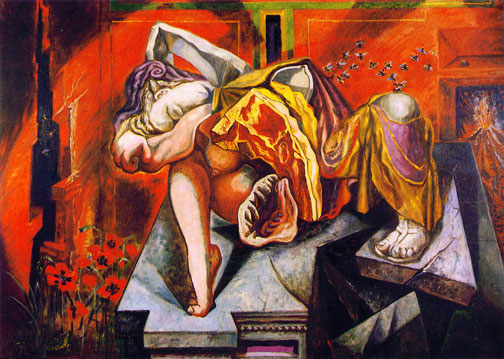
From "Gradiva"
Cavell's update of Plato's allegory from the Socratic dialogue to the film comedy of remarriage offers a convenient transition for our assignment-- an equivalent of the Republic, outlining an electrate relation among education, justice, and the city. The transitional figure is Sigmund Freud, whom Cavell includes in his review of the philosophical tradition contributing to moral perfectionism. Cavell's insight into this continuity is based on Freud's appropriation of a novel--Gradiva, by Wilhelm Jensen--as an allegory of the analytic method of therapy. Cavell recognizes in the theme and plot of the novel the features of the remarriage comedy. Freud's study of the novel was his first discussion of a literary work. The protagonist, a young archeologist (Norbert Hanold), "who had surrendered his interest in life," in Freud's paraphrase, referring to his aversion to sexuality and incapacity for love, "in exchange for an interest in the remains of classical antiquity and how he is brought back to real life by a roundabout path," a path devised by a girl from his childhood, whom he meets again while visiting the ruins of Pompeii. The story is summarized in an abstract:
A young archaeologist had discovered in a museum of antiquities in Rome a relief which attracted him. He obtained a plaster cast of it. The sculpture represented a fully grown girl stepping along, with her flowing dress a little pulled up so as to reveal her sandaled feet. The interest taken by the hero of the story in this relief is the basic psychological fact in the narrative. As an outcome of studies, he was forced to the conclusion that Gradiva's gait was not discoverable in reality; and this filled him with regret and vexation. Soon afterwards he had a terrifying dream, in which he found himself in ancient Pompeii on the day of the eruption of Vesuvius and witnessed the city's destruction. Gradiva disappeared and the hero searched for her. She appeared to come to life in someone else's body. Hanold met her, Zeo Bertgang, and they went away together. With the triumph of love, what was beautiful and precious in the delusion found recognition as well. In his last simile, however, of the childhood friend who had been dug out of the ruins, Jensen presented the key to the symbolism of which the hero's delusion made use in disguising his repressed memory.
(Abstracts of the Standard Edition of the Complete Psychological Works of Sigmund Freud, International Universities Press, New York, 1973: 187).
Cavell reviews the terms of the analogy of the novel with psychoanalytic therapy, observing that Norbert is the patient, showing that his delusion, "is the state of every human being before discovering the truth or reality of his own experience, namely that it is a life-and-death struggle with unconsciousness, that its unawareness of what it is expressing at every moment, despite itself, is a kind of delusion. But a delusion is 'essentially' how Plato in the Republic pictures everyday (or 'ordinary') experience in the Allegory of the Cave" (Cavell, 292). The role of a work of art as mediator or go-between is relevant. The bas-relief sculpture referenced in the fiction is actual, named "Gradiva" ("she who walks") after the Roman god of war striding into battle. This relay was central also in Proust, the character Swann finally falling in love with the courtesan Odette when he recognizes in her face the features of a painting he admired, Botticelli's Zipporah, Jethro's daughter. All the registers of the popcycle are in play in the narrative: Family (the repressed childhood experience with Zoe); Mythology (Gradiva story); History (Pompeii); Career: Archaeology.
Because of Freud's attention to Jensen's novel, the Gradiva figure became iconic for Surrealist artists, including Salvador Dali, Andre Breton, Andre Masson, and Michel Leiris, among others. That Cavell's connection falls on the side of literacy, identifying psychoanalysis as transistioning to a new occupation of the educational conversation, may be seen in what Andre Masson does with the Gradiva icon. The surrealists picked up on the central (fetishistic) detail that fascinated the protagonist in the sculpture, "with her strange walk, one foot held almost perpendicular to the ground." Masson, however, makes explicit the dimension of desire addressed in electrate metaphysics. "The artist transforms this scene [at Pompeii] into an evocation of unbridled libidinal force. The Pygmalion-like motif of stone becoming flesh is here metaphorically extended so that Gradiva's torso becomes a raw steak, while her vagina turns into a gaping shell. A swarm of bees suggests an ambiguous honey sweetness seeping from this half-rotten body" (Jennifer Mundy, Ed., Surrealism: Desire Unbound, Princeton, 2001: 64).
Share this
Comments

The Talking Cure

Jensen's Gradiva as allegory of Freud's analytic therapy clarifies reoccupation as method: The question remains consistent across epochs: education as a lover's discourse. The relays transduce from the Socratic dialogue through the remarriage comedy. When we arrive at the practice and institution of psychoanalysis, created by Sigmund Freud, in a history that coincides with that of cinema. a new answer to the question emerges, a new mode of educational conversation, opening up a further dimension of desire and love that constitute the scene of metaphysics to be designed and tested for electracy. The electrate allegory we seek is proposed within this new kind of conversation that became known as the "talking cure." This appellation was given by the young woman considered to be its first patient (or analysand), known as Anna O., whose real name was Bertha Pappenheim, later an important feminist and founder of social work in Germany. She was originally the patient of Joseph Breuer, to whom Freud gave much credit for the treatment. Freud was trained in neurophysiology, but the mechanist positivism of his day had no answer for the symptoms of hysteria, such as those manifested by Anna O, which had no physical cause. In Cavell's terms, hysteria manifested explicitly the blocked communication of melodrama that imprisoned people in the cave of dissatisfaction, repressed desire, against Eros, fostering Thanatos. The discovery was that when Anna simply started saying whatever came to her mind, improvising without reflection, free associating through a monologue, that this verbalization affected her body, relieved her various forms of paralysis. She called it the talking cure, and also referred to it as "chimney sweeping." The significance of this latter phrase for us is that it is also the source in French for a slang term, fumisme, naming the mocking attitude associated with the "Spirit of Montmartre," the scene of bohemian Paris in whose cabarets the modernist avant-garde was inventing the logic of electrate metaphysics. A fumiste is a chimney sweep, with slang extension to name a joker, crackpot, fraud, and in fact recent commentators on Anna O.'s behavior and symptoms have suggested she might have been "blowing smoke" at the credulous doctors. One of her symptoms that seemed genuine enough was the hysterical pregnancy: she believed she was carrying a child fathered by Breuer.
What aligns the remarriage comedy of Jensen's Gradiva with the relation of Anna O. and Dr. Breuer is this "love" (and hate) that arises during therapy, called "transference." Indeed, what recommends the psychoanalytic conversation as a relay for inventing electrate education is that through this love-in-effigy the unconscious appears. We might say that the analytic session is for desire what nuclear reactors are for material forces--creating special conditions within which dimensions of unstable elements manifest themselves. Transference is an experience in which the analysand (patient) repeats with the analyst in the present a relationship of dis/satisfaction set in the past. The metaphysics of any apparatus accounts for time-space-cause constituting its reality, and transference is one site for noticing, studying, and gaining access to the time-space-cause native to electracy.
We noted at the opening that the discourse of electrate learning is self-addressed, which does not mean that learning happens in solitude. Socrates practiced dialectic without knowing how to write (it is said), and Freud invented psychotherapy without having been analyzed. The other source of access to the unconscious, in addition to the free-associating monologue of the analysand, is dreams. Freud started documenting and interpreting his own dreams, exploring the temporal objects revealed in transference, applying the lessons learned in the clinic to himself, ultimately described and theorized in his monumental The Interpretation of Dreams. The self-analysis was carried out in part through correspondence with his friend and colleague, Wilhelm Fliess. Freud himself is a transitional figure between literacy and electracy, in that he was a positivist scientist who reintroduced into medical and human studies the entire body of cultural creativity--not only dreams but mythology, jokes, literature, arts of all kinds. Plato at the beginning of literacy famously expelled the poets from his utopian republic, due to their blasphemous irrational representations of the gods. Freud invites this blasphemous irrational version of reality to return, since it turns out to be a more accurate version of the real forces of desire structuring human reality than the propositional logics of pure reason. Freud is the true heir of Kant in this respect, following up Kant's promotion of aesthetic judgment to equal standing with pure and practical reason as the intellectual capacities (virtues, powers) of human beings.
